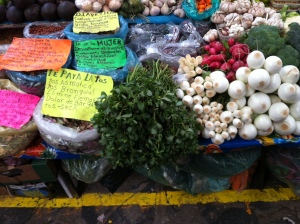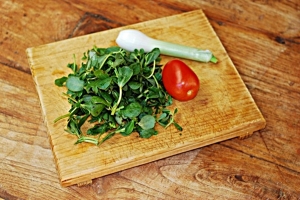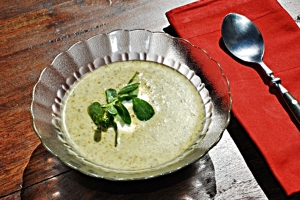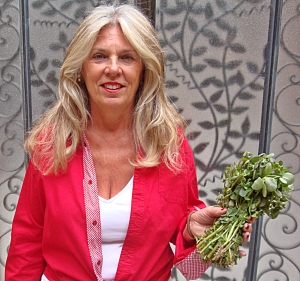It’s difficult for me to remember anything my father and I had in common during my early teen years. Except perhaps one thing that united us. We both disliked almost all foods that came in any shades of green. Yet, on almost every day of my adolescence, my mother placed a mound of chopped iceberg lettuce before us, tossed it on not so pleasurable days with cucumber, tomatoes, radishes and celery; on better days with egg, tuna or salmon; and on the most tolerable days with apples and walnuts.
When I left the family home I made a number of vows – most were about enlightening myself about the mysteries of foreign lands and the female anatomy but one was about food. Salad greens would never again touch my lips.
Apart from a few instances where politeness prevailed, I kept that promise until I was in my late twenties. My career aspirations had taken a dramatic detour from Fleet Street to Madison Avenue and my lunches had changed from corned to fine cuts of beef. On those first few visits to that specially reserved corner table at the advertising community’s midday place of merriment, I discovered that ad men had appetites almost as big as their egos, and a starter was as de rigeur as the three or four martinis required to tolerate each others bragging for the also de rigeur three hours.
What amazed me was that the choice of starter amongst the “elite” (a status earned by the number of times per year one’s name appeared in the pages of Advertising Age) was a salad. Grown men ordering greens; it was as strange to me (and would have been to my father) as women ordering blood pudding.
On about my fifth visit to this restaurant, the temple of all things steak, I was sat at the table of the creative director of ad agency Doyle, Dane, Bernbach. He had been involved (though we never knew quite how much) in the Volkswagen “Lemon” campaign which had made him the reigning emperor of our midday haunt in those days and I desperately wanted to be one of his subjects. The salad he ordered for his starter was only served for two or more and, when his choice fell on deaf ears around the table, I announced that it would be my pleasure to join him.
The dish was new to me; it was called a Caesar and it was as much an event as it was a salad. A tuxedoed waiter came and performed a juggling act tableside for almost 15 minutes over the largest wooden bowl imaginable. One of the few things I recognized was eggs; I hoped that the creative director/emperor hadn’t noticed my cringe when I saw that after they were ceremoniously cracked and whisked, they entered the mix raw. The end result, looking as creamy as a dessert, was placed on dinner sized plates and served with both a knife and fork.
It was good. It was very, very good. The creative director raised his eyebrows as a way of approving my appreciation. And though it was probably the bacon, the anchovies, the garlic and the parmesan that should have received the credit, I gave most of the acclaim to the romaine or, at least perhaps, the romance of the occasion.
When I shared my joy with others at that hallowed corner table, the copywriter we called “the oracle” (even when he didn’t know all, he was brilliant at pretending to) spun a colorful saga of how the Caesar Salad was one of Mexico’s greatest contributions to cuisine. I doubt if anyone believed him…I certainly didn’t, but it was decades before we could source instant answers from the internet. On my first trip to the then Mexican destination-of-choice, Acapulco, I realized he was correct…and under my breath, I whispered an apology to him.
I was now, for the first time in my life, a liker (if not a lover) of salad greens and I proceeded through the salad spin cycle over the years. Spinach, frisee, rocket, radicchio (amazing how a difference in color can lead to something being vastly overrated), endive, bibb, arugula (rocket had a different name the second time around), watercress, mesclun, and, finally, the latest and perhaps greatest of my green experiences: verdolaga.
Though this is Don Day’s tenth winter in San Miguel de Allende, Mexico, it was only five years ago that I discovered verdolaga. I was at San Miguel’s Tuesday Market and purchased a small bunch of watercress. Well at least I thought it was watercress. I asked Leticia, our maid and cook what it was called in Spanish. She told me verdolaga. From that I got the words green and lake and decided, yes, that must be what Mexicans call watercress. Leticia gave it its bath in BacDyn and I tried a sprig and then another and another. I had never tasted watercress without the bitterness. This was very, very good, even without a dressing to disguise it. It was crunchier; it was tangier; it reminded of the pea shoots that I could never resist ordering in Chinese restaurants; perhaps this wasn’t cress after all.
Don Day went to he who knows even more than my old copywriter cronies, Wikipedia. No verdolaga there. Next came Google. Again, nothing. I suddenly felt like an explorer in the new world. I remembered Keats’ lines about someone else discovering something else new in Mexico:
“Then felt I like some watcher of the skies
When a new planet swims into his ken;
Or like stout Cortez, when with eagle eyes
He stared at the Pacific—and all his men
Looked at each other with a wild surmise…”
Perhaps, I had discovered something unknown to most of the culinary world. Perhaps, when they give verdolaga an English moniker, they’ll name it after Don Day (I still have an ad man’s ego). I mean did Louis Antoine de Bougainville do any more than buy a plant from a Mexican to get bougainvillea named after him?
We began to use verdolaga in salads. Often. Don Day’s Wife would use it in her innovative soup creations. We both began to enjoy it more and more until, one day, I officially declared verdolaga to be Don Day’s favorite salad green.
In April of last year I headed north leaving verdolaga behind and almost forgotten. In December of this year, I returned to San Miguel and the quest for more information began anew. I again went to Wikipedia. Again nothing. I again went to Google and there were thousands of entries (as there now always seems to be for absolutely every word).
I learned that verdolaga is known in Europe as purslane. I remembered the word and remembered eating it in salads when I lived in France in the late seventies. I also remembered asking what the green was in my regular takeout lamb curry in London, England and being told it was purslane.
I discovered that the Latin name for the plant was portulaca oleracea and recalled growing hybridized versions for their colorful flowers when I lived in San Francisco. They would creep from the rich soil that I had diligently created with bags of peat moss and loam to the dry, sandy cracks between concrete blocks that were their much preferred home. I cherished the way the blossoms would open their eyes with the sunrise and close them at sunset.
In trying to find out more about its relationship to Mexico, the website www.worldcrops.org told me that “Verdolaga is a vegetable green used in many Latin American countries. It is believed to be native to Iran or India, although it was present in the New World at the time of European colonization.”
In San Miguel de Allende, you can pick your own wild verdolaga. The photograph above I took last week in front of the Ford dealership on Salida a Celaya where little in San Miguel grows except windswept piles of dust. On the steps above El Chorro, San Miguel’s original source of water, I have often seen leather-skinned women with pairing knives, edging verdolaga out of the cracks and placing it in their apron pockets. I was sure verdolaga would be a native to Mexico but I was wrong.
I learned that it was Mahatma Gandhi’s favorite food which for some reason conjured up visions of Ben Kingsley doing an infomercial for verdolaga while dressed in saffron robes (it’s impossible to destroy an ad man’s commercial slant).
So where can you buy verdolaga and what should you do with it? I’ve already mentioned the Tianguis Municipale that’s held on Tuesdays. There are at least three or four stalls that sell it (if you have trouble locating a stall, the one that is in the furthest southeast corner of the market always seems to have it).
You’ll also find verdolaga (as Don Day’s Wife did today) in the outdoor area at the Ignacio Ramirez Market; just ask one of the ladies who are seated on the pavement selling cactus paddles and other vegetables and they’ll direct you to the one who almost always has it. Plus I’ve also seen verdolaga at Mega, San Miguel’s most frequented supermarket on several occasions.
What if you want to eat it out somewhere? There may be restaurants, particularly those catering to local tastes, but the only one Don Day knew that ever used verdolaga frequently was Café Rama on Calle Nueva. Those were the days when Jason Malloff was chef but when Jason departed, it seems so did the verdolaga. Jason Malloff would use it in his butter chicken as well as his Asian chicken a la Mexicana. He once told me, “I prefer it raw. It has a nice, fresh, almost citrusy flavor.” He also agreed with Don Day that it is perhaps the world’s most underappreciated green.
Like Gandhi, Malloff recognized the nutritional value of verdolaga (did Don Day just compare a chef to the father of the Indian nation?). The website, www.specialtyproduce.com tells us, “This green is rich in vitamin A, vitamin C and magnesium with a fair amount of potassium and calcium. One-half cup has about 10 calories. An exciting new health discovery is the high content of alpha linolenic acid present in verdolagas or purslane, a type of the omega-3 fatty acids. Research is finding these substances lower blood pressure and cholesterol levels as well as helping to prevent blood clots.”
What truly surprised Don Day about the use of verdolaga is that, though it’s popular in central Mexico, it only seems to get used in one place. Soups. Maids and cooks that have worked for us give us that head bent to the side, roll the eyes look when we have asked them to include it in salads.
I spent a while thinking about sharing one of Don Day’s Wife’s salad recipes using verdolaga; my decision was instead to suggest taking any simple salad that calls for lettuce or spinach or arugula or watercress or any other green and replace it with verdolaga. While that would exclude a complicated creation like a Caesar, there’s not much else that wouldn’t work.
And speaking of replacing spinach or arugula. The photo above is from a hearty pasta sauce that Don Day’s Wife made this week. She often gives the sauce a little added freshness in the last couple of minutes before it’s served by throwing in a handful of baby spinach, arugula or basil. This one, a variation on puttanesca, had verdolaga.
Instead of a salad recipe, Don Day will leave you with this suggestion on how to share my joy over verdolaga: Go to El Maple bakery on Salida a Celaya and purchase one of their sandwich buns. Then go next door to Luna de Queso and purchase 150 grams of soppresatta salami and a wedge of their delightful aged Gouda. The three year old cheese, agreeably, is pricey but, in my opinion, it’s the best taste of dairy you can find in San Miguel these days.
Slice the bun lengthwise. Spread each side with New Zealand or Danish butter (or if your spouse is like Don Day’s Wife, and watching, you can dispense with the butter) then spread one side with a thin layer of Dijon mustard. Layer all of the soppresatta on the lower side, followed by shavings of about 100 grams of the Gouda (a vegetable peeler is excellent for slicing cheese). Then top it with a generous handful of the verdolaga. Cover with the other slice of sandwich bun and bring it slowly to your mouth in anticipation. You’re about to savor a sandwich that’s enough for two normal people or, if you’re an old ad man like Don Day, enough for one.
Buen provecho!









Have you checked out Victorias blogpost at flavorsofthesunblogpost.com? Just use the search button for verdolaga. Victoria is an absolutely incredible source of info on all things food in sma. She has lived here 21 years! I would think you would enjoy each other.
Saludos, Maryanna
>
One of my favorite blogs. I get hungrier with every new post.